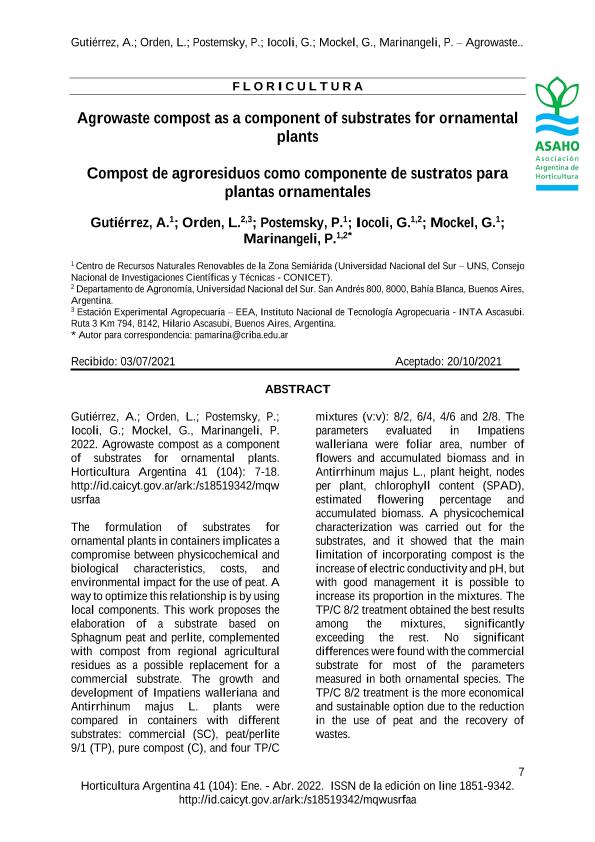Artículo
En la formulación de sustratos para plantas ornamentales en contenedores existe un compromiso entre las características físicoquímicas y biológicas, los costos y el impacto ambiental por el uso de turba. Una forma de optimizar esta relación es utilizando componentes locales. Este trabajo propone la elaboración de un sustrato en base a turba Sphagnum y perlita, complementado con compost de residuos agropecuarios regionales como posible reemplazo de un sustrato comercial. Se comparó el crecimiento y desarrollo de plantas de Impatiens walleriana y Antirrhinum majus L. en contenedores con diferentes sustratos: comercial (SC), turba/perlita 9/1 (TP), compost puro (C), y cuatro mezclas TP/C (v:v): 8/2, 6/4, 4/6 y 2/8. Los parámetros evaluados fueron: área foliar, número de flores y biomasa acumulada para Impatiens walleriana y altura de planta, nudos por planta, contenido de clorofila (SPAD), porcentaje de floración estimado y biomasa acumulada para Antirrhinum majus L. Se realizó la caracterización físicoquímica de los sustratos evaluados, observándose que la principal limitante de incorporar compost es el incremento en la conductividad eléctrica y en el pH, pero que con buen manejo permite incrementar su proporción en las mezclas. El tratamiento TP/C 8/2 obtuvo los mejores resultados entre las mezclas, superando significativamente al resto. No se encontraron diferencias significativas con el sustrato comercial para la mayor a de los parámetros medidos en ambas especies ornamentales. El tratamiento TP/C8/2 es la opción más económica y sustentable debido a la reducción del uso de turba y al aprovechamiento de residuos. The formulation of substrates for ornamental plants in containers implicates a compromise between physicochemical and biological characteristics, costs, andenvironmental impact for the use of peat. A way to optimize this relationship is by using local components. This work proposes the elaboration of a substrate based on Sphagnum peat and perlite, complemented with compost from regional agricultural residues as a possible replacement for a commercial substrate. The growth and development of Impatiens walleriana and Antirrhinum majus L. plants were compared in containers with different substrates: commercial (SC), peat/perlite 9/1 (TP), pure compost (C), and four TP/C mixtures (v:v): 8/2, 6/4, 4/6 and 2/8. The parameters evaluated in Impatiens walleriana were foliar area, number of flowers and accumulated biomass and in Antirrhinum majus L., plant height, nodes per plant, chlorophyll content (SPAD), estimated flowering percentage and accumulated biomass. A physicochemical characterization was carried out for the substrates, and it showed that the main limitation of incorporating compost is the increase of electric conductivity and pH, but with good management it is possible to increase its proportion in the mixtures. The TP/C 8/2 treatment obtained the best results among the mixtures, significantly exceeding the rest. No significant differences were found with the commercial substrate for most of the parameters measured in both ornamental species. The TP/C 8/2 treatment is the more economical and sustainable option due to the reduction in the use of peat and the recovery of wastes.
Compost de agroresiduos como componente de sustratos para plantas ornamentales
Título:
Agrowaste compost as a component of substrates for ornamental plants
Gutierrez, Agustina ; Orden, Luciano; Postemsky, Pablo Daniel
; Orden, Luciano; Postemsky, Pablo Daniel ; Iocoli, Gastón Alejandro
; Iocoli, Gastón Alejandro ; Mockel, Gabriela Carolina
; Mockel, Gabriela Carolina ; Marinangeli, Pablo Alejandro
; Marinangeli, Pablo Alejandro
 ; Orden, Luciano; Postemsky, Pablo Daniel
; Orden, Luciano; Postemsky, Pablo Daniel ; Iocoli, Gastón Alejandro
; Iocoli, Gastón Alejandro ; Mockel, Gabriela Carolina
; Mockel, Gabriela Carolina ; Marinangeli, Pablo Alejandro
; Marinangeli, Pablo Alejandro
Fecha de publicación:
01/2022
Editorial:
Asociación Argentina de Horticultura
Revista:
Horticultura Argentina
e-ISSN:
1851-9342
Idioma:
Español
Tipo de recurso:
Artículo publicado
Clasificación temática:
Resumen
Archivos asociados
Licencia
Identificadores
Colecciones
Articulos(CERZOS)
Articulos de CENTRO REC.NAT.RENOVABLES DE ZONA SEMIARIDA(I)
Articulos de CENTRO REC.NAT.RENOVABLES DE ZONA SEMIARIDA(I)
Citación
Gutierrez, Agustina; Orden, Luciano; Postemsky, Pablo Daniel; Iocoli, Gastón Alejandro; Mockel, Gabriela Carolina; et al.; Compost de agroresiduos como componente de sustratos para plantas ornamentales; Asociación Argentina de Horticultura; Horticultura Argentina; 41; 104; 1-2022; 7-18
Compartir



